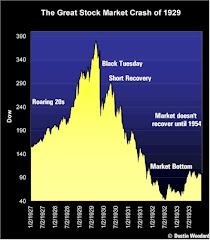Canada's Finance Minister announces countrywide consultations on Canada's pension system.
Overview of Canada's current system
CTV coverage
CBC coverage
The initial information from the government shows how good our system is in Canada. It is one of the best in the world and provides some of the highest retirement income for seniors in the world.
Interesting Facts
The "pension assets" in Canada are listed by the Finance department as being $1.8 Trillion:
They break down like this in a Statscan 2007 report
CPP/QPP - $ 157 Billion
Public Sector
Public sector pensions $ 606 Billion
Super Sized public sector pensions top-up $ 199 Billion
(Government consolidated revenue arrangements)
Private Sector
Registered Retirement Savings Pensions $ 739 Billion
Private sector pensions $ 314 Billion
Other - annuities, insurance companies $ 102 Billion
I an assuming that the $ 300 Billion difference between 2007 and the 2009 numbers are the market losses over the past 2 years. Note the public sector employees (25% of workers) have accumulated a total of $ 805 Billion in retirement assets and the private sector pensions and RRSP's have accumulated $1.053 Billion.
Pension reform needed
One interesting issue has not discussed. If the system we have is good enough for taxpayers, why is it not good enough for the public sector. Canadians have had to funnel billions of tax dollars into public sector plans to provide gold-plated pensions for MPs, MLA's and public employees.
You can see from the numbers above there are two levels of pensions in Canada. One for the taxpayers and one for the public servants.
The most glaring difference are the rules that the public sector has created for themselves. In the numbers above we see the special top-up public sector pensions. These are technically known as SERPS or Supplementary Employee Retirement Plans. They are designed for civil servants who go over the usual pension limit the average taxpayer must abide by.
They are described by Osler as:
Most SERPs are retirement or pension plans that provide for retirement income payments in excess of those provided under “registered pension plans” (which are qualified or tax assisted plans). Registered pension plans are subject to “defined benefit” or “defined contribution” limits designed to limit the benefits that may be funded through such plans on a tax assisted basis. Because of those limits, registered pension plans often do not provide adequate income replacement for higher income employees, and SERPs are commonly used to supplement or “top up” the benefits (of public servants)These are the really big earners who earn over $120,000 per year. The Ontario Sunshine List has over 53,000 of these guys.
Illinois Reforms Pensions
In the US they are having to deal with the financial repercussions of these plans and have started to make changes. Sweeping state pension overhaul proposed
Illinois has tabled some excellent reform ideas to make the system more fair. I will contrast them with Canada.
- Anyone hired by schools, universities, state or local governments after Jan. 1 would have to work until 67 to get full retirement benefits. In Canada the usual pension age is 50 for emergency services and 55 for the rest of the public sector.
- The pension would be based on the highest consecutive 8 years out of the last decade of service. In Canada the gold standard is 3 years.
- Maximum salary for figuring a pension would be capped at $106,80. In Canada with SERPS there are no limits. On the Sunshine List there are hundreds of public sector workers who will earn, when fully qualified over $200,000 per year. Thousands at over $100,000 per year and at the bottom end tens of thousands are guaranteed a $70,000 per year in pensions. Even the bottom ones are almost twice the average Canadian's working wage.
- Annual pension cost-of-living increases, now an automatic 3 percent, would be limited to half the rate of inflation or 3 percent. In Canada the 3% is pretty standard or the rate of inflation whichever is lower. (Guess who setts the inflation rate? Government economists)
- As for double dippers, the proposed law would ban people from collecting one government pension while taking another public sector job. The first pension would be suspended during the duration of the second job. Upon retirement, the person could then collect both pensions. In Canada there is limited control on double dippers, they usually have to move to a different level of government ie. municipal to provincial to federal.
The Grapes of Wrath
I have been reading an amazing book called the Grapes of Wrath by John Steinbeck. He won the Pulitzer Prize for it. A story of the Great Depression, it is as relevant today as when it was written.
Men who have created new fruits in the world cannot create a system whereby their fruits may be eaten. And the failure hangs over the State like a great sorrow. ...and in the eyes of the people there is the failure; and in the eyes of the hungry there is a growing wrath. In the souls of the people the grapes of wrath are filling and growing heavy, growing heavy for the vintage.Will the process move all Canadians to the same level of pensions? Or will we continue on with our two-tier pension system?




No comments:
Post a Comment